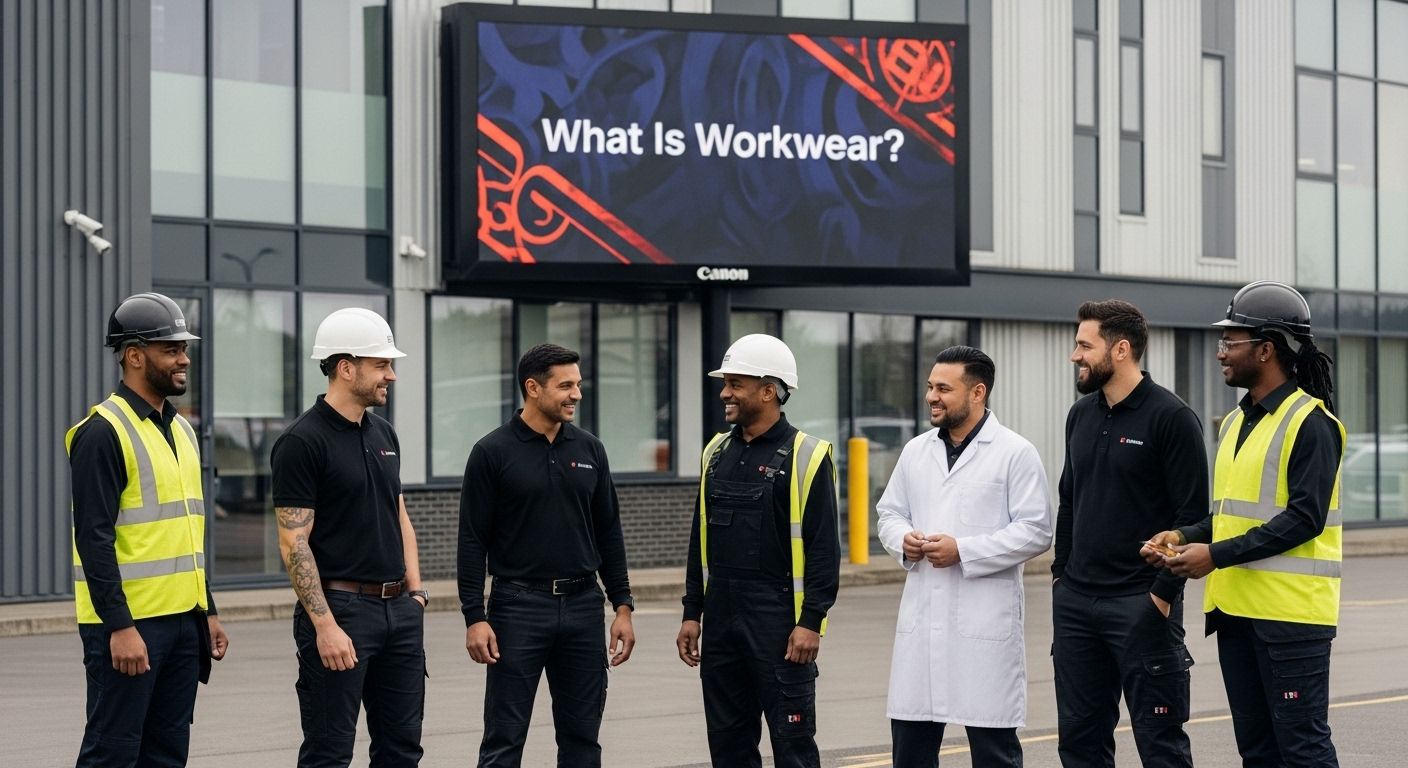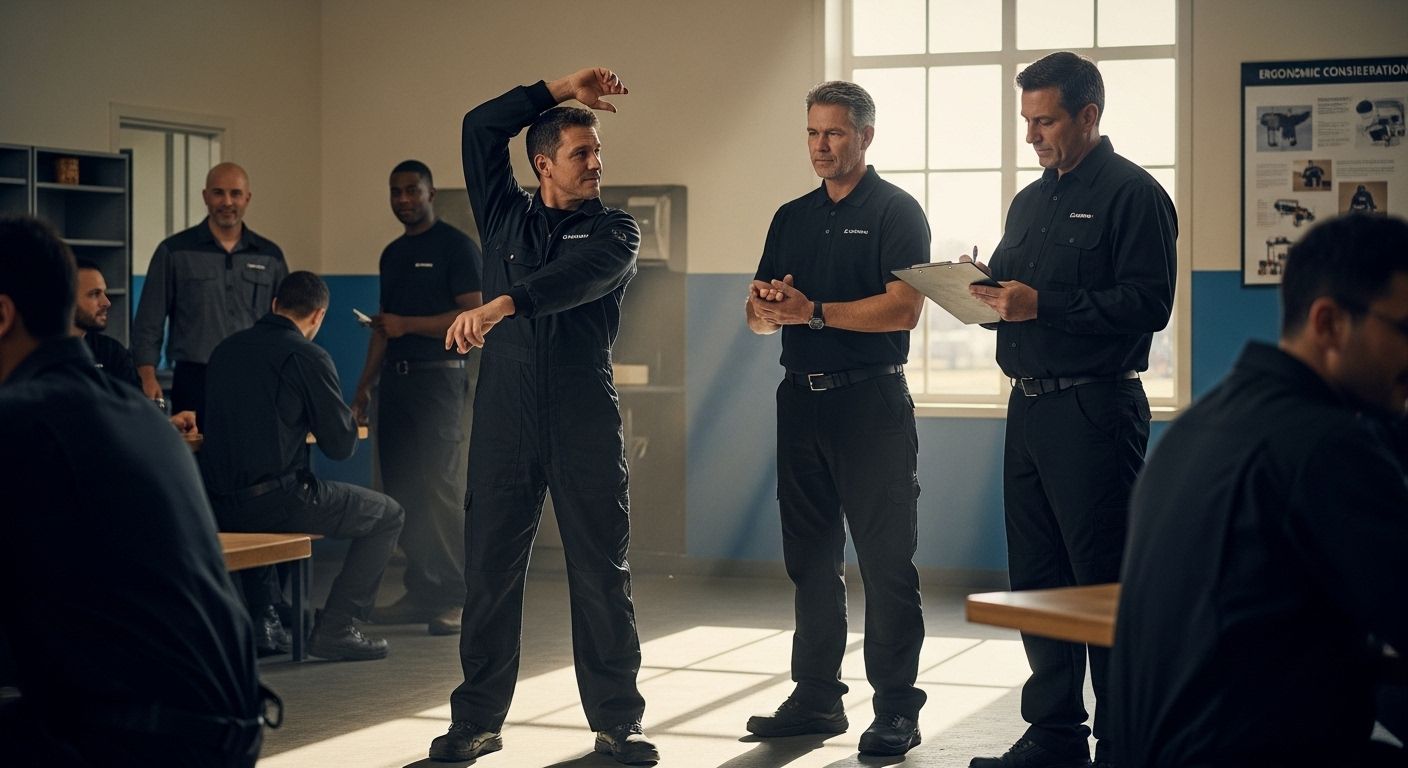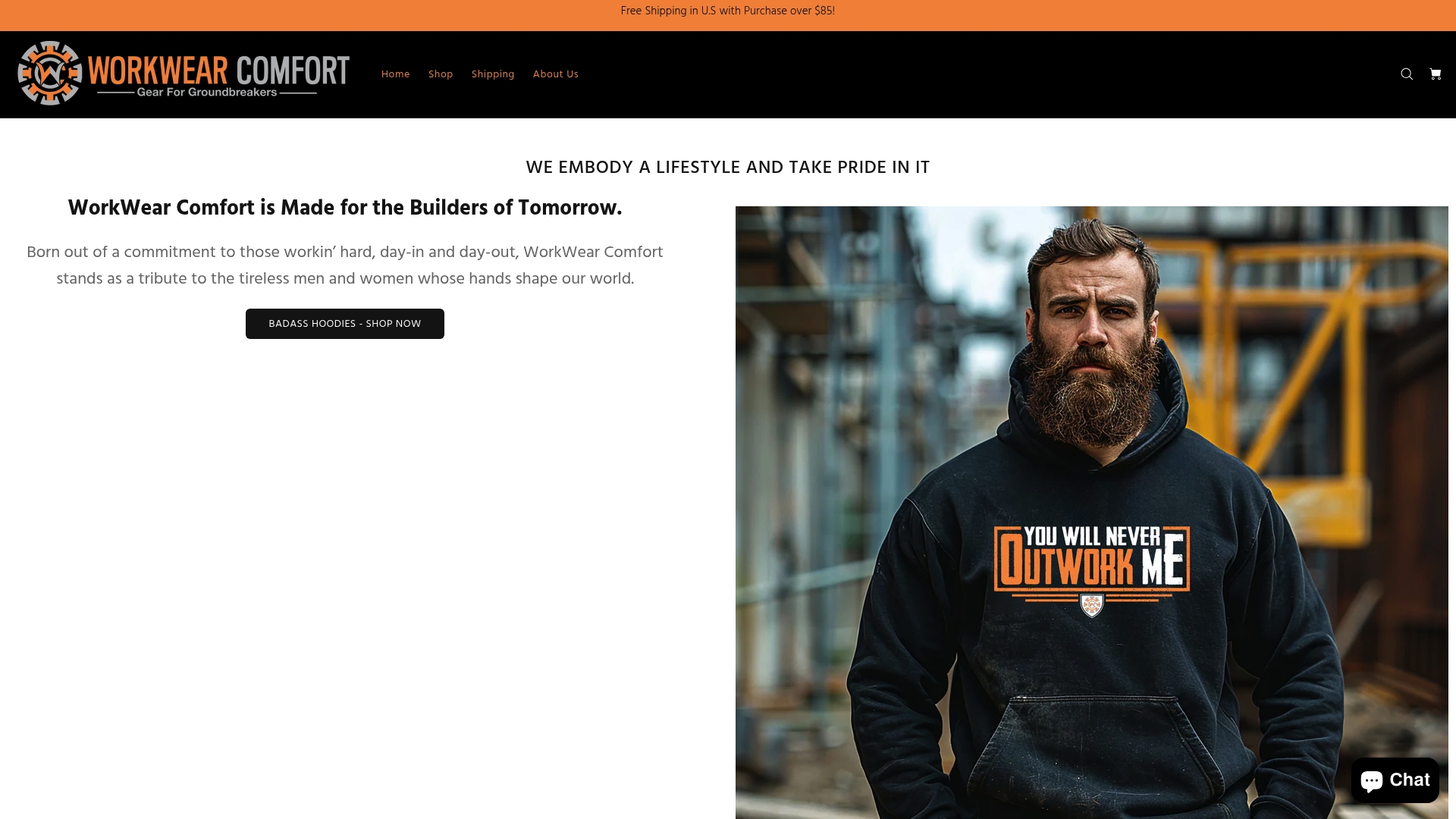
Workwear shapes how millions of hardworking people stay safe and productive every day. Roughly 2.8 million workplace injuries happen in the US each year, and the right clothing can make all the difference between protection and risk. Most folks think workwear is just about tough fabric or a uniform look, but what makes modern workwear truly stand out is the blend of advanced technology, ergonomic comfort, and specialized design that actually reshapes what it means to work safely in 2025.
Table of Contents
- Defining Workwear And Its Purpose
- Key Features Of Durable Work Clothing
- Workwear Styles For Different Professions
- How To Choose The Right Workwear In 2025
Quick Summary
| Takeaway | Explanation |
|---|---|
| Workwear ensures safety and protection | Protective clothing shields workers from injuries and hazardous environments, enhancing safety significantly. |
| Choose durable materials for longevity | Select workwear made from reinforced fabrics that resist wear and abrasion to maximize lifespan and functionality. |
| Consider ergonomic design for comfort | Opt for clothing with articulated joints and stretch panels for unrestricted movement, enhancing work efficiency. |
| Select appropriate styles for your profession | Different jobs require specific workwear styles; identify your field’s requirements for optimal performance. |
| Prioritize advanced technology in fabrics | Incorporate textiles that manage moisture, temperature, and provide durability for better overall performance in demanding conditions. |
Defining Workwear and Its Purpose
Workwear represents more than just clothing. It is a critical component of professional identity and safety for hardworking individuals across multiple industries. Research from Wikipedia defines workwear as specialized clothing designed specifically for manual and physical labor, emphasizing both functionality and protection in demanding work environments.
The Essential Function of Workwear
At its core, workwear serves three fundamental purposes: protection, durability, and performance. Professionals in construction, trades, agriculture, and other physically demanding fields require clothing that can withstand extreme conditions while providing critical safety features. According to vocabulary experts, workwear goes beyond standard clothing by incorporating design elements that address specific workplace challenges.
The protection aspect of workwear is paramount. Workers in hazardous environments need clothing that shields them from potential injuries, extreme temperatures, chemical exposures, and mechanical risks. Robust materials like reinforced canvas, heavy-duty denim, and specialized synthetic blends create a protective barrier between the worker and potential workplace dangers.
Design Principles of Professional Workwear
Workwear design follows a comprehensive approach that balances multiple critical factors. Durability remains the primary consideration. Clothing must withstand repeated use, frequent washing, and exposure to harsh working conditions without compromising its structural integrity. Professional-grade workwear typically features triple-stitched seams, reinforced stress points, and high-tensile strength fabrics that resist tearing and wear.
Functionality is equally important. Strategically placed pockets, adjustable features, and ergonomic design elements transform workwear from simple clothing into versatile tools. Professionals need clothing that allows unrestricted movement while providing convenient storage for essential tools and equipment. Check out our guide on professional work apparel to explore how modern workwear combines style with practical design.
Performance considerations extend beyond physical protection. Modern workwear incorporates advanced textile technologies that manage moisture, regulate body temperature, and provide breathability. Workers in physically demanding roles require clothing that helps maintain comfort and prevents fatigue during long, challenging shifts.
The purpose of workwear transcends mere clothing. It represents a professional’s commitment to safety, efficiency, and performance. From construction sites to agricultural fields, workwear embodies the resilience and strength of hardworking individuals who form the backbone of our economic infrastructure.
Key Features of Durable Work Clothing
Durable work clothing represents a critical investment for professionals who face challenging work environments daily. According to OSHA, the primary objective of workwear extends beyond simple clothing protection to creating a comprehensive safety barrier that shields workers from potential workplace hazards.
Material Strength and Resilience
The foundation of durable work clothing lies in its material composition. Research from the National Institute for Occupational Safety and Health highlights that superior workwear must demonstrate exceptional resistance to abrasion, tearing, and punctures. Professional-grade fabrics like heavy-duty canvas, reinforced denim, and high-performance synthetic blends offer unparalleled durability.
Key material characteristics include high tensile strength, which prevents fabric breakdown under stress, and advanced textile technologies that maintain structural integrity after repeated use and washing. Workers require clothing that can withstand constant movement, exposure to harsh chemicals, extreme temperatures, and mechanical stress without compromising protection or comfort.

Strategic Design and Reinforcement
Durable work clothing goes far beyond basic fabric selection. Strategic design elements transform ordinary garments into professional-grade protective equipment. Reinforced stress points like knees, elbows, and pocket areas prevent premature wear and extend the garment’s functional lifecycle.
Advanced workwear incorporates multiple design innovations. Triple-stitched seams provide additional strength, while strategically placed reinforcement panels create extra protection in high-impact zones. Explore our professional work apparel collection to see how modern design principles enhance clothing durability.
Ergonomic considerations are equally important. Articulated joints, stretch panels, and breathable fabric zones allow unrestricted movement while maintaining structural integrity. These design elements ensure that workers can perform demanding physical tasks without feeling constrained by their clothing.
Performance and Protection Technologies
Modern work clothing integrates sophisticated performance technologies that extend far beyond traditional protective gear. Advanced moisture-wicking fabrics help regulate body temperature, preventing fatigue and maintaining worker comfort during long shifts. UV-protective treatments shield workers from harmful solar radiation, while specialized coatings offer resistance to water, oil, and chemical splashes.
Some high-performance workwear includes embedded safety features like reflective elements for increased visibility, built-in knee pad pockets, and specialized ventilation systems. These technological innovations transform work clothing from a simple protective layer into a comprehensive safety and performance enhancement tool.
Ultimately, durable work clothing represents an essential investment in professional safety, comfort, and efficiency. By selecting garments that combine advanced materials, strategic design, and performance technologies, workers can confidently tackle challenging environments while minimizing risk and maximizing productivity.
Here is a table summarizing the key features and technologies found in durable work clothing as discussed above, organized for easy comparison.
| Feature/Technology | Purpose | Common Examples |
|---|---|---|
| Durable Fabrics | Withstand abrasion, tearing, and punctures | Heavy-duty canvas, reinforced denim, synthetic blends |
| Reinforced Stress Points | Prevent wear at high-impact areas | Reinforced knees, elbows, pocket edges |
| Triple-Stitched Seams | Increase strength and garment lifespan | Seams on work pants, jackets |
| Ergonomic Design Elements | Enable unrestricted, comfortable movement | Articulated joints, stretch panels |
| Advanced Moisture Management | Regulate temperature, improve comfort | Moisture-wicking textiles, breathable fabrics |
| UV/Water/Chemical Resistance | Protect against environmental hazards | UV treatments, water/chemical-resistant coatings |
| Built-In Safety Features | Enhance on-the-job protection | Reflective strips, knee pad pockets, ventilation |
Workwear Styles for Different Professions
Workwear represents a complex landscape of professional attire that varies dramatically across different industries and job roles. According to Wikipedia’s comprehensive overview, occupational clothing has evolved significantly, reflecting the unique demands and safety requirements of various professional environments.
Industrial and Trade Profession Workwear
Constructors, welders, mechanics, and agricultural workers require robust workwear that provides maximum protection and functionality. These professions demand clothing with reinforced materials, high visibility features, and specialized protective elements. Heavy-duty denim, canvas work pants, flame-resistant fabrics, and multiple-layered garments characterize workwear in these physically demanding sectors.
Specialized workwear for industrial professions often includes integrated safety features like reflective strips, multiple tool pockets, and strategic reinforcement at stress points. Check out our blue-collar work apparel collection to explore professional-grade clothing designed for maximum durability and performance.
Professional Services and Technical Workwear
Research from the Education Bureau’s Life Planning Information Website highlights the nuanced approach to workwear in professional services. Technical roles in fields like engineering, IT, and laboratory sciences require clothing that balances professional appearance with functional requirements.
These professionals often wear business casual or smart casual attire that allows mobility while maintaining a polished look. Lightweight, breathable fabrics with stretch capabilities, moisture-wicking properties, and wrinkle-resistant materials are crucial. Performance fabrics that transition seamlessly between office environments and field work have become increasingly popular.
Safety and Compliance in Workwear Design
According to Do2Learn’s workplace guidance, workplace attire is not just about appearance but also about safety, identification, and compliance with industry regulations. Some professions mandate specific uniforms or protective gear to ensure worker safety and organizational consistency.
Emergency responders, healthcare workers, and military personnel have highly specialized workwear designed with precise specifications. These garments incorporate advanced materials that provide protection against environmental hazards, chemical exposures, and potential physical risks. Features like antimicrobial treatments, flame resistance, and integrated cooling systems demonstrate the sophisticated engineering behind modern professional clothing.
The diversity of workwear reflects the complexity of modern professional environments. From rugged construction sites to sterile laboratory settings, clothing serves as a critical tool that enhances worker safety, performance, and professional identity. Understanding the specific requirements of different professions helps workers and employers select appropriate workwear that meets both functional and regulatory standards.
The table below compares typical workwear styles, features, and key requirements for several common professional sectors discussed above.
| Profession/Industry | Common Workwear Styles | Key Features and Requirements |
|---|---|---|
| Construction & Trades | Heavy-duty pants, jackets, overalls | Reinforced fabrics, high visibility, tool pockets, safety features |
| Welding/Industrial | Flame-resistant coveralls, boots | Heat/flame protection, reinforced stress points, durability |
| Agriculture | Layered clothing, hats, boots | Breathability, UV protection, mobility, chemical resistance |
| Professional Services (Office) | Business casual, polos, slacks | Professional look, comfort, stretch, moisture-wicking |
| Technical/Field Services | Smart casual, technical shirts/pants | Mobility, transition-ready fabrics, wrinkle resistance |
| Healthcare/Emergency Response | Uniforms, scrubs, protective gear | Antimicrobial, easy to sanitize, specialized PPE |
| Military/Security | Tactical uniforms, boots, accessories | Flame resistance, compliance, cooling/integration systems |
How to Choose the Right Workwear in 2025
Choosing the right workwear in 2025 requires a strategic approach that balances safety, performance, and technological innovation. According to the National Institute for Occupational Safety and Health, selecting appropriate professional clothing involves a comprehensive evaluation of workplace conditions, potential hazards, and individual job requirements.
Conducting a Comprehensive Workplace Hazard Assessment
The foundation of selecting appropriate workwear begins with a thorough hazard assessment. Professionals must carefully analyze their specific work environment, identifying potential risks such as chemical exposures, mechanical stress, temperature extremes, and potential impact zones. Explore our professional work protection guide to understand the critical factors in workwear selection.
Key assessment factors include evaluating the frequency and duration of exposure to specific workplace hazards, understanding the potential severity of risks, and identifying the specific protective characteristics required. Workers should consider factors like flame resistance, chemical repellency, electrical hazard protection, and visibility requirements specific to their professional context.
Technology and Material Selection Criteria
OSHA guidelines emphasize the importance of selecting workwear that meets current safety standards, highlighting the critical role of advanced materials and technological innovations. Modern workwear selection goes beyond traditional fabric choices, incorporating smart textiles and performance-enhancing technologies.
Professionals should prioritize workwear with the following technological features:
- Adaptive Temperature Regulation: Fabrics that manage body temperature in extreme work environments
- Advanced Moisture Management: Materials that quickly wick away sweat and prevent discomfort
- Integrated Protection: Clothing with built-in UV protection, antimicrobial treatments, and impact-resistant zones
- Sustainable Materials: Eco-friendly fabrics that reduce environmental impact without compromising durability
Personalized Fit and Ergonomic Considerations
 Choosing workwear is not a one-size-fits-all approach. Proper fit is crucial for both safety and performance. Workers must consider their body type, range of motion requirements, and specific job demands when selecting professional clothing.
Choosing workwear is not a one-size-fits-all approach. Proper fit is crucial for both safety and performance. Workers must consider their body type, range of motion requirements, and specific job demands when selecting professional clothing.
Ergonomic features like articulated joints, stretch panels, and adjustable components ensure maximum mobility and comfort. Professionals should look for workwear that allows unrestricted movement while maintaining protective capabilities. This means testing garments for flexibility, assessing weight distribution, and ensuring that clothing does not impede natural work movements.
The workwear selection process in 2025 represents a holistic approach that combines safety science, technological innovation, and personalized design. By carefully evaluating workplace risks, understanding advanced material technologies, and prioritizing individual fit and comfort, professionals can select workwear that not only protects but also enhances their overall work performance and well-being.
Frequently Asked Questions
What is workwear?
Workwear refers to specialized clothing designed for manual or physical labor, emphasizing functionality, safety, and protection in demanding work environments.
Why is it important to choose durable materials for workwear?
Durable materials ensure that workwear can withstand repeated use, exposure to harsh conditions, and prevent wear and tear, which is essential for maintaining safety and performance.
How can ergonomic design improve workwear?
Ergonomic design enhances comfort and mobility by incorporating features such as articulated joints and stretch panels, allowing workers to perform their tasks without restriction and reducing fatigue.
What technological advancements are incorporated into modern workwear?
Modern workwear includes advanced moisture-wicking fabrics, UV protection, and integrated safety features like reflective elements and built-in knee pad pockets, all of which enhance worker comfort and safety.
Discover Workwear That Works as Hard as You Do
Are you tired of work clothing that falls short on protection or leaves you uncomfortable during a tough shift? This guide shows how the right workwear prevents injuries and keeps you performing at your best. If durability, ergonomic fit, and modern features like UPF 50+ sun protection sound like what you need, check out our specialized Blue-Collar Working Man Sweatshirt Hoodies. These are built for strength, comfort, and everyday wear in real jobsite conditions.

Stop settling for gear that does not live up to your hard work. Visit WorkwearComfort.com now and explore apparel designed to help you meet every challenge with confidence. Upgrade your work wardrobe today and experience the difference quality makes on the job.


